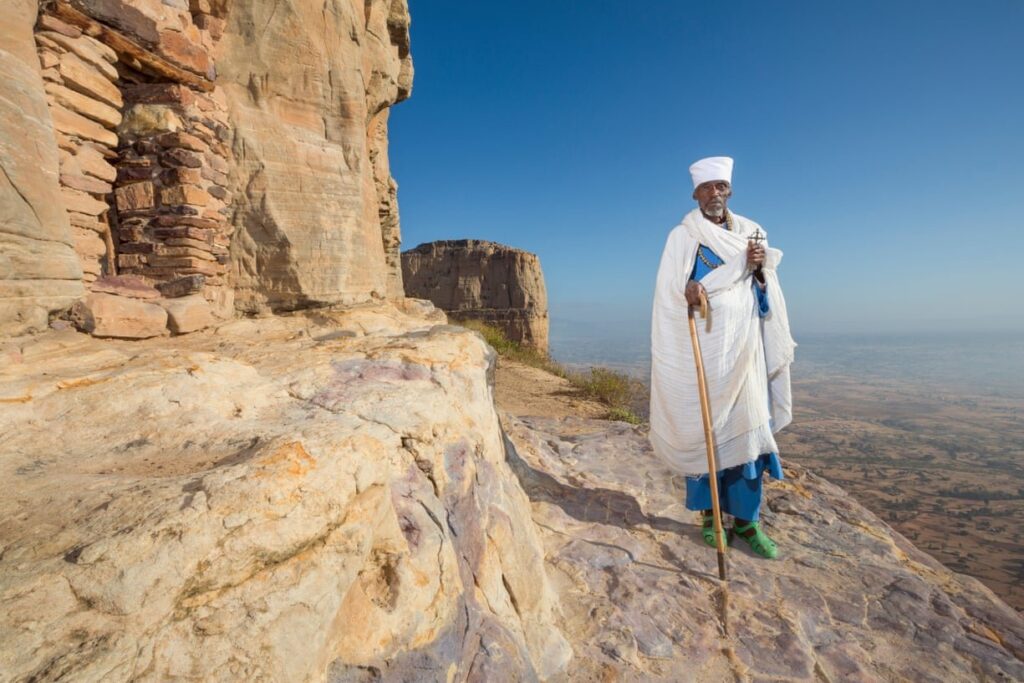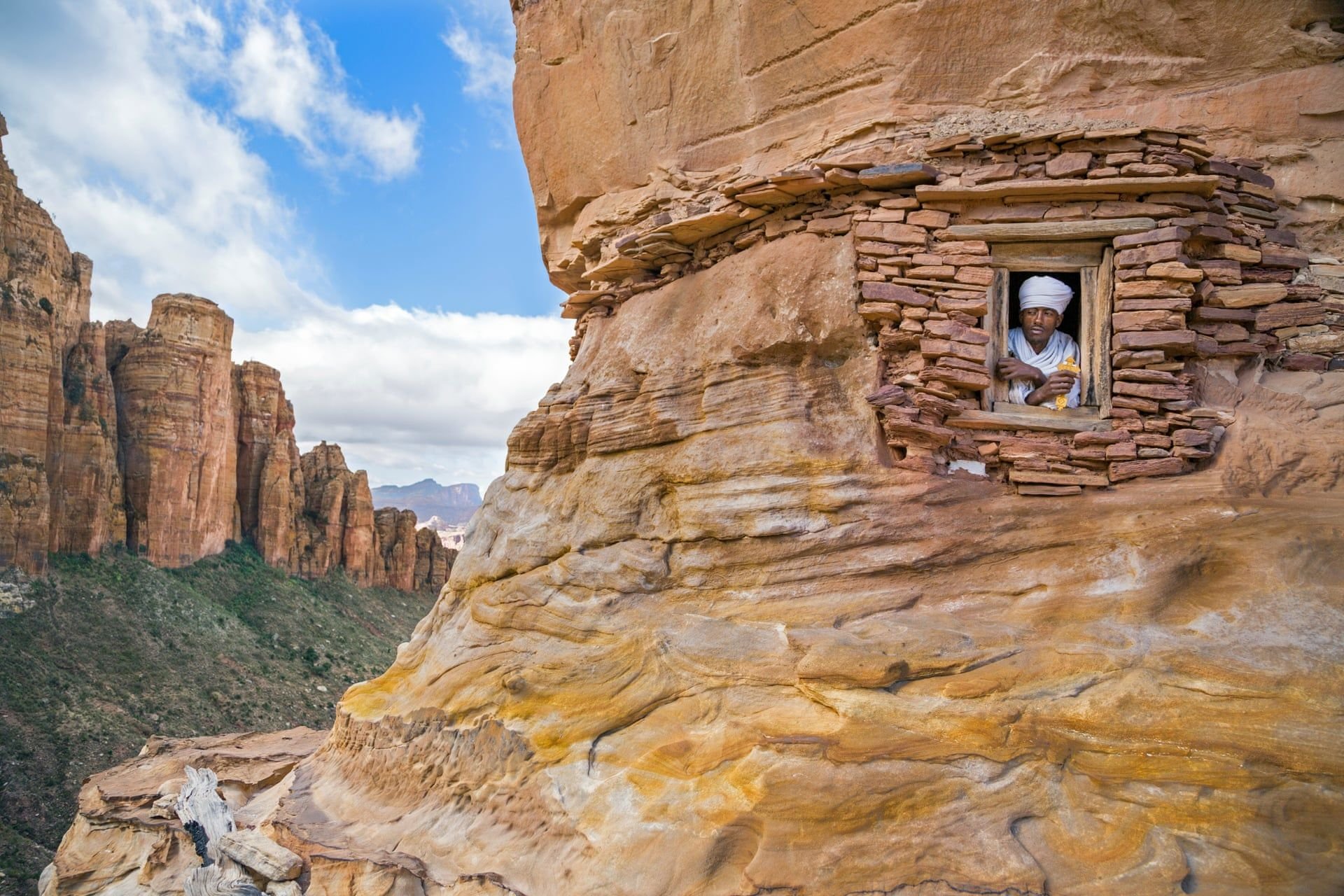Ethiopia is a land of hidden treasures, and one of the most intriguing of these is Abuna Yemata Guh. Situated amidst the mountains of Ethiopia’s Tigray region lies one of Ethiopia’s best-kept secrets, a rock-hewn church believed to date back to the 5th century.
Inside this ancient church, one can marvel at vibrant paintings that appear new but are, in fact, over 600 years old. Would you take the risk to witness such a magnificent site?
Well in this article, we invite you to explore one of the world’s oldest Christian nations – Ethiopia, to learn about the history of Christianity in the country, and to discover one of its most renowned rock-hewn Ethiopian Orthodox churches, Abuna Yemata Guh.
Abuna Yemata Guh is perhaps the world’s most remote place of worship, situated at a height of 2,500 meters.
It is carved into the side of a cliff, surrounded by a sheer drop of 650 meters on all sides, making it incredibly inaccessible.
Abuna Yemata Guh is a church that stands alone, carved into the side of a cliff in the Hawzen woreda of the Tigray Region, Ethiopia.
At a height of 2,580 metres (8,460ft), the church is only accessible on foot and is renowned for its remarkable architecture, dome, and stunning wall paintings dating back to the 5th century.
To reach the church, visitors and worshippers must first cross a natural stone bridge with a perilous drop of approximately 250m (820ft) on either side.
Then, they must pass through a narrow wooden footbridge, followed by a challenging climb up a vertical rock wall, relying solely on hand grips and foot holds, and barefooted, as the ground is considered holy. Finally, they must walk along a narrow 50cm wide ledge facing a sheer drop of 980ft.
The History of Abuna Yemata Guh
Abuna Yemata Guh, also known as the Church of St. Yemata, is a rock-hewn church located in the Gheralta Mountains of Tigray, northern Ethiopia.
Abuna Yemata Guh is a marvel of engineering and devotion. Carved entirely out of one single stone, this ancient church in northern Ethiopia is a testament to the human spirit’s tenacity and creativity.
Abuna Yemata Guh, the monolithic church was erected by St. Abuna Yemata, one of the nine saints who brought Christianity to Ethiopia in the late fifth century, having journeyed from Syria, Constantinople, or Rome.
The church itself is believed to have been built in the 13th century, during the reign of King Lalibela, and is considered one of the most remarkable examples of Ethiopia’s rock-hewn architecture.
The church is carved out of the side of a cliff, about 2,500 meters above sea level. To reach the church, visitors must climb a steep, narrow, and often treacherous path that winds its way up the cliff face. The climb can take up to an hour, depending on one’s level of fitness and acclimatization to the altitude.
Once inside the church, visitors are rewarded with stunning frescoes and carvings, including depictions of biblical scenes and saints. The church is also home to a collection of ancient manuscripts, some of which date back to the 6th century.
Father Assefa, a seasoned climber who has been scaling the rock for years, assures visitors that the routes to Abuna Yemata Guh are blessed.

According to him, no one has ever lost their life during the climb, as the patron saint of the church saves those who may fall with his wind, returning them safely to the ledge halfway down.
Climbing the rock has been a family tradition for Father Assefa, as his grandfather was also a priest at Abuna Yemata Guh, and generations of priests have been laid to rest among the rocks.
According to researchers, the journey to reach this holy site is not for the faint of heart. The initial 45-minute climb to the church is moderately challenging, with a few difficult sheer sections requiring the use of toeholds.
Guides carry ropes, which cost Birr 150, for the final ascent. The last two minutes of the climb are particularly demanding and require exceptional nerve to undertake the final scramble and precarious walk along a narrow ledge perched on a 200m drop.
The hike itself is the most challenging part of the journey. To avoid slipping off the mountain edges, you must remove your shoes and socks before the hike.
The first challenge is to walk along numerous narrow, cliff-hugging ledges. Following that is the toughest part of the climb – a climb up a vertical rock wall with a 300m sheer drop.
If you manage to make it this far, take a moment to catch your breath before crossing a natural stone bridge with a drop of approximately 250m on either side.
Also read: 4 Important Religious Festivals in Ethiopia
Reaching the destination does not mean the thrilling yet nerve-wracking journey ends – you still have to descend the mountain using your bare feet again.
Despite the dangerous route to Abuna Yemata Guh, local priests in their 80s make the journey for service, and mothers carry their newborns to be baptized.
The church is well-preserved, with paintings executed only with natural colors, a sight that is worth the ‘risk’ to many religious art lovers.
Fortunately, priests and locals are stationed there to help those ascending the mountain, and tipping each of them around 100 Birr (US$4) will guide you through the slippery rocks and push you upwards when you lack strength.
They will also point out the ‘natural’ indents in the wall where you can put your hands and feet in, as coaches would do in rock climbing lessons. You can also borrow a climbing rope at the nearby town beforehand from tour guides for around 500 Birr (US$18 – 20) to be extra safe.
This church is home to some of the oldest Christian art in the world. The paintings adorning the walls of the church were created in the 15th century using natural pigments sourced from flowers, fruits, and minerals.
The arduous climb required to reach the church means that only a select few visitors have seen the artwork, thus preserving it in exceptional condition.
Additionally, the interior is kept dark when the front door is shut, reducing the risk of sun damage to the paintings.
When the door is opened, the daylight seeps in slowly, revealing the vibrancy of the frescoes that depict nine of the twelve apostles of Christ.

These detailed depictions, with their intricate lines and vibrant colours, give the impression that the church was built only a few years ago.
In the Ethiopian Orthodox Church, a person’s holiness is reflected by having their entire face visible, including both eyes.
Conversely, individuals who are considered evil, such as sinners and those who reject God, are depicted in profile, with only one eye visible.
This unique portrayal method makes it easy to distinguish between good and evil in Ethiopian Orthodox icons.
There are various speculations as to why Father Yemata selected such an inaccessible location to construct the church.
Some believe that the treacherous journey to reach the church represents the path to heaven, the search for true divinity.
Others suggest that Father Yemata desired a secluded spot for worship. Nevertheless, the question remains: how did Father Yemata manage to build this church over 1500 years ago without the aid of modern tools and machinery? This mystery may remain unsolved forever.
The Significance of Abuna Yemata Guh
Abuna Yemata Guh is not only significant for its architecture and artwork but also for its religious and cultural significance.
The church is an important pilgrimage site for Ethiopian Orthodox Christians, who make the perilous climb to pay their respects to St. Yemata and to seek spiritual guidance and blessings.

The church also has historical significance, as it is believed to have been used as a hiding place for early Christians during times of persecution. The church’s remote location and hidden entrance made it a safe haven for those fleeing persecution, and it is said that the church’s construction was intended to be a secret so as not to attract unwanted attention.
Visiting Abuna Yemata Guh: Challenges and Precautions
As stated earlier, visiting Abuna Yemata Guh is not for the faint of heart. The climb up to the church is steep, narrow, and requires a good level of fitness and agility. Visitors must also be prepared to climb barefoot, as shoes are not allowed inside the church.
In addition to the physical challenges, there are also safety concerns to consider. The climb involves scaling steep cliffs, and there have been reports of accidents and fatalities in the past. Visitors are advised to hire a local guide who is familiar with the terrain and can ensure their safety.
Another consideration for visitors is the altitude. Abuna Yemata Guh is located at an elevation of 2,500 meters, which can cause altitude sickness in some people.
Visitors are advised to acclimatize themselves before attempting the climb and to take precautions such as drinking plenty of water and avoiding alcohol.
So when next you visit Ethiopia and you feeling like doing daring activities, here’s one to consider.
Source

